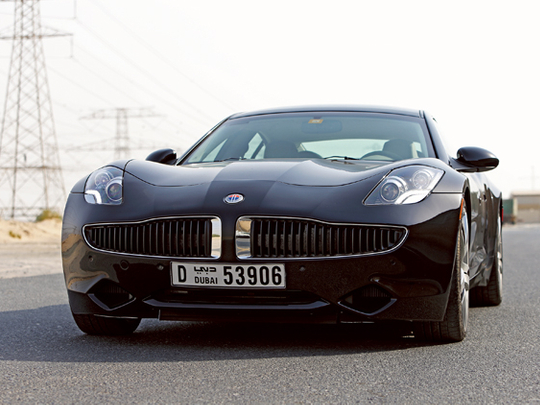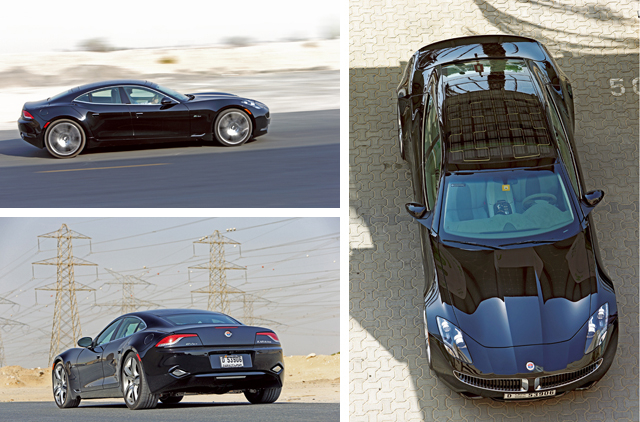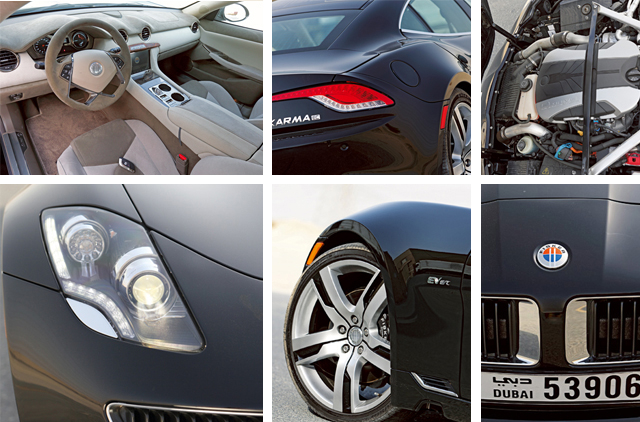
You know you’re having a good day when your editor rings you early in the morning and invites you to enjoy Karma at lunchtime. I mean, how kind is that. “Good Karma I hope, Amit,” was my immediate reaction, to which he replied “Well it’s the only one in the Middle East so you tell me how good it is”.
Now that wasn’t the answer I was expecting. But then the Fisker Karma, designed by Dane Henrik Fisker and built in that well-known automotive hub of Uusikaupunki in Finland, is not the green car I was expecting either. The Fisker is a rather different kettle of environmentally friendly fish, not only miserly in its CO2 emissions, but striking in its design.
To my eye there are elements of Quattroporte bodywork, Z4 grille, even the haunches of a Camaro in the Karma’s design, which sounds like it ought to be an unappetising mix, but in reality this is a good-looking car. Sat on simply enormous 22in alloys, and with a bonnet which seems to stretch over half the length of the car (especially when you’re driving) it demands attention, and revels in it too.
Tucked under that bonnet is one half of the Karma’s motive power, a General Motors-built 260bhp, 2.0-litre turbocharged petrol engine, but what you won’t find under there is a gearbox, because that engine isn’t connected to the wheels, not mechanically anyway. Instead it’s bolted to a generator used to charge a bank of on-board batteries, with a total capacity of 20kWh.
Those drive two 120kW electric motors, one at each rear wheel, via a limited slip differential, but if like me, you have a hard time comparing two electric motors with a burbling V8, just be content in the knowledge that the Karma benefits from 1,300Nm of torque, and that all of the torque is available the moment you put your foot down. Which is nice.
Now as you know, torque isn’t cheap, and until you can buy a Karma from official dealer Trading Enterprises in October, you’ll have to rent one of these beauties. Well, this particular beauty since it’s the only game in town and it’ll set you back a cool Dh5,000 a day from Green Car Rental, which kindly loaned us its vehicle for the day. Certainly not the cheapest rental car you’ll ever hire, but almost certainly one of the most exclusive, and very cool-looking into the bargain.
Speaking of cool, take a look on the roof where you’ll find your very own gold-effect solar panel. In sunny climates, the panel helps, slightly, to power the air conditioning, thus reducing the load on the car’s battery power. But never mind that, just be happy that it looks great.
Out on the road the car’s no slouch in a straight line, those torque blessed electric motors accelerating the Fisker to 100kph from standstill in just over six seconds, but driving it that way comes at a cost — you’ll flatten your batteries in no time.
They weren’t fully charged when I collected the car and in the few minutes it took me to drive from Al Quoz to Safa Park down Shaikh Zayed Road, admittedly whilst testing the car’s acceleration, the dashboard display politely informed me that I’d killed all my kilowatts. What? Already?
Even on a full charge, the maximum range of the Karma in electric mode only, that is, with no assistance from the petrol-driven generator, is in the order of 60 to 70 kilometres — though that’s probably enough to get the vast majority of residents to work and back within Dubai or Abu Dhabi. Throw in the motive power of the engine/generator, and on a full tank, that range is extended to 400+ kilometres, so an Abu Dhabi-to-Dubai commute’s not out of the question.
You’ll eke out a little more mileage if you’re driving downhill because, of course, when you take your foot off the throttle, the Karma uses its momentum to regenerate electrical power, dynamo-style. Although calling it KERS-style makes it sound more exciting. You’d be pretty comfortable on that long drive too, the Fisker’s interior being a smartly enough trimmed cabin, utilising what I’m told are many recycled materials.
Don’t worry, there were no visible signs of polyethylene bottle caps and old newspapers, but instead a pleasant soft-weave fabric across the dash and door trims, and alcantara (or a very good recycled impression of alcantara) above the dashboard, and on the wheel.
The seats were supportive and with good grip, though my efforts at flinging this 2,400kg saloon around the corners were limited, since I was now relying on a two-litre petrol engine to drive a generator, to charge a battery, to power two electric motors to make me go fast enough to hang the back end out. I failed.
The Luddite in me longed for a big fat juicy eight-cylinder engine instead, but the New Age traveller appreciated how quiet it was in the cabin, and how much less CO2 I was pumping out using a two-litre powerplant not a four-litre. The suspension is a fraction soft but well set up nonetheless; it doesn’t wallow, in fact it’s a very comfortable, executive saloon ride.
Steering is a little on the heavy side but that’s exactly to my liking, and although there’s noticeable understeer, it’s only when you’re pushing on in the corners and, frankly, that’s rather missing the point in a vehicle of this type. There’s room in the rear seats for two, not three adults, because the batteries run the length of the car, splitting the rear seats with a dividing beam, albeit one nicely trimmed with real leaves under glass panels.
Now there’s something you don’t see every day. These days several car companies seem happy to provide seating for four, not five passengers, so Fisker’s not alone in this approach. The AC was effective, coping well with the 47-degree outside air temperature, though I’m sure that had probably contributed to the drain of the battery.
The rear view from the mirror was quite restricted because the roof-top solar panel drops well down the back of the car, but despite the car’s size — it’s very nearly five metres long and two metres wide — I faced no problems positioning it on the road. Just watch those alloys when turning into car parks — that bonnet stretches out to the horizon from the driver’s seat.
Although hybrid cars ultimately take their power from oil-burning power stations here in the UAE, laying waste to claims of significant CO2 emission savings, Green Car has installed its own twin-car-bay solar-powered charging station alongside Shaikh Zayed Road. This allows the rental company to use the car for a 20 kilometre commute each day, and charge it for ‘free’ before the return journey in the evening.
Except that large solar-powered charging stations are really quite expensive to install. However, Green Car has plans to build a second station in Al Quoz, and will shortly open an office at Dubai Airport and begin promoting low-emission car rentals to the UAE’s millions of visitors.
Even this confirmed petrolhead accepts that for all our sakes, if the power used to charge hybrids and electrical vehicles is generated using non-polluting technologies, and if those cars are as good looking and pleasant to drive as the Fisker, then there’s a place for them on our roads. And judging by the reaction of passers-by and onlookers, there’s a place for Karma in their lives too. Which is good.
* Thanks to Green Car Rental, Dubai, for the loan of the Fisker Karma. www.greencardubai.com
* The test car featured here is not GCC spec. Trading Enterprises, part of the Al-Futtaim Group, the sole distributors for Fisker across the MENA region, will launch the Karma in late October. Trading Enterprises will offer a full range of sales and after-sales service in the UAE.













